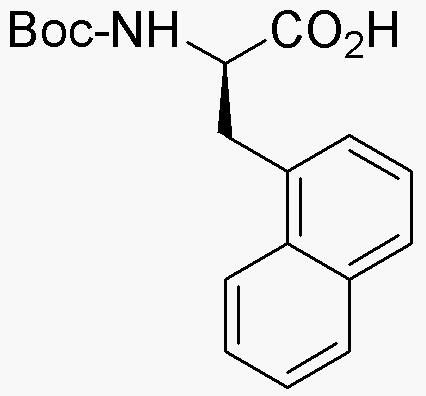Boc-3-(1-naphthyl)-D-alanine is widely utilized in research focused on:
- Peptide Synthesis: This compound serves as a valuable building block in the synthesis of peptides, particularly in the development of biologically active compounds and pharmaceuticals.
- Drug Development: It plays a crucial role in drug discovery, especially in creating compounds that target specific biological pathways, enhancing therapeutic efficacy.
- Biochemical Research: Researchers use it to study protein interactions and enzyme activities, contributing to a deeper understanding of cellular processes.
- Material Science: The compound is explored in the development of novel materials with unique properties, such as improved stability and functionality.
- Cosmetic Formulations: Its applications extend to the cosmetic industry, where it is used in formulations aimed at enhancing skin health and appearance.
General Information
Properties
Safety and Regulations
Applications
Boc-3-(1-naphthyl)-D-alanine is widely utilized in research focused on:
- Peptide Synthesis: This compound serves as a valuable building block in the synthesis of peptides, particularly in the development of biologically active compounds and pharmaceuticals.
- Drug Development: It plays a crucial role in drug discovery, especially in creating compounds that target specific biological pathways, enhancing therapeutic efficacy.
- Biochemical Research: Researchers use it to study protein interactions and enzyme activities, contributing to a deeper understanding of cellular processes.
- Material Science: The compound is explored in the development of novel materials with unique properties, such as improved stability and functionality.
- Cosmetic Formulations: Its applications extend to the cosmetic industry, where it is used in formulations aimed at enhancing skin health and appearance.
Documents
Safety Data Sheets (SDS)
The SDS provides comprehensive safety information on handling, storage, and disposal of the product.
Product Specification (PS)
The PS provides a comprehensive breakdown of the product’s properties, including chemical composition, physical state, purity, and storage requirements. It also details acceptable quality ranges and the product's intended applications.
Certificates of Analysis (COA)
Search for Certificates of Analysis (COA) by entering the products Lot Number. Lot and Batch Numbers can be found on a product’s label following the words ‘Lot’ or ‘Batch’.
Numéro de catalogue
Numéro de lot/série
Certificates Of Origin (COO)
This COO confirms the country where the product was manufactured, and also details the materials and components used in it and whether it is derived from natural, synthetic, or other specific sources. This certificate may be required for customs, trade, and regulatory compliance.
Numéro de catalogue
Numéro de lot/série
Safety Data Sheets (SDS)
The SDS provides comprehensive safety information on handling, storage, and disposal of the product.
DownloadProduct Specification (PS)
The PS provides a comprehensive breakdown of the product’s properties, including chemical composition, physical state, purity, and storage requirements. It also details acceptable quality ranges and the product's intended applications.
DownloadCertificates of Analysis (COA)
Search for Certificates of Analysis (COA) by entering the products Lot Number. Lot and Batch Numbers can be found on a product’s label following the words ‘Lot’ or ‘Batch’.
Numéro de catalogue
Numéro de lot/série
Certificates Of Origin (COO)
This COO confirms the country where the product was manufactured, and also details the materials and components used in it and whether it is derived from natural, synthetic, or other specific sources. This certificate may be required for customs, trade, and regulatory compliance.


